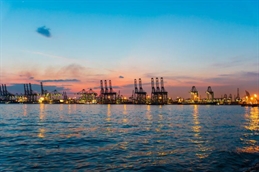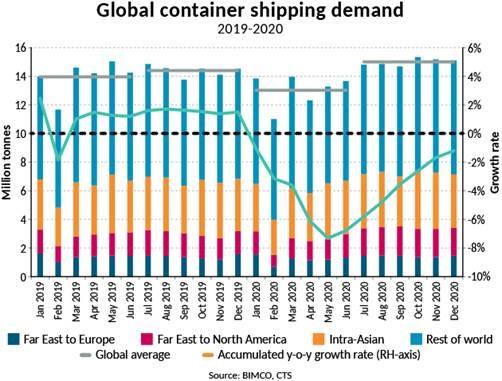
BIMCO, the largest international shipping association, controlling around 65% of the world’s tonnage, said container shipping has emerged triumphant despite the disruptions last year.
In a statement, it said for full-year 2020, global container shipping volumes fell by 1.2% compared with 2019, much less than feared even before the pandemic was first declared, and much recovered compared with the 6.8% drop recorded in the first six months of the year.
It said volumes in the second half of the year were also up 4.2% from 2019 — much of this growth concentrated on just a few trade lanes, with congestion and imbalances on these spilling out and causing disruption on other trades, it added.
"BIMCO expects that 2021 will be even better for container shipping than 2020, as the current backlog will take months to clear and carriers are using the current strength of the market to lock in long-term contract rates for the coming 12 months at higher levels than in 2020," it said.
The shipping association noted that by far the largest volume growth was seen on the Far East to North America trade.
"The second half growth caused major disruptions in many US West Coast ports, as they were unable to keep up with record-high volumes while implementing social distancing among workers at the same time, due to the pandemic. "

Weaker H2 recovery on the other major trades
"Of the three most important, high-volume trades, the Far-East to North America was the only one to grow over the full year, as growth on intra-Asian and Far East to Europe trades in the second half of the year was not enough to make up for H1 losses," BIMCO said in its release.
After falling by 1.1 million TEUs in the first half of the year, volumes between the Far East and Europe were only up by 0.2 million TEU in the second half of 2020, leaving full-year volumes on this trade down 5.2% compared with 2019.
On the Intra-Asian trades, a 2.2% growth in the second half of the year compared to H2 2019, was not enough to recover a 4.0% loss in the first half.
BIMCO noted that there were only very few trades that bucked the trend and grew in the first half of the year — one of them was the Indian subcontinent and Middle East exports to the Far East; the thirteenth largest trade which saw volumes increase by 115,000 TEU in H1 2020 compared to the same period in 2019.
“The particularly strong recovery in demand for containerised goods in the US was driven by a rise in consumer spending, particularly on goods for the homes that people have been spending much more time in, as well as higher spending on goods as consumers were unable to spend what they usually do on services,” says Peter Sand, BIMCO’s chief shipping Analyst.
“As manufacturing in consuming countries has struggled to recover to its pre-pandemic levels, imports have outgrown demand for a number of goods in order to fill the gap. This development is hugely beneficial for shipping.”
Uptick in volumes soon played out on spot freight rates
BIMCO noted that freight rates did not experience the same drop as volumes did in the first half of the year, as carriers pushed losses onto tonnage providers. Charter rates did however fall steeply from mid-February to June.
At the same time, it added that demolitions slowed, contracting picked up, with 65 new ships amounting to 751,057 TEU being ordered.
In the full year, the container shipping fleet grew by 2.9% in 2020 as 857,616 TEU was added to the market compared to 188,800 TEU being demolished.
“The high earnings that carriers have achieved in recent months is not a reflection of better fundamentals in the container shipping market, but rather a result of how 2020 has developed. In the longer run, this artificial tightness in the market will subside and container shipping will once again have to deal with the pre-pandemic overcapacity in the market, made worse by new orders made in recent months,” Sand added.
“As to the current disruption and equipment shortages, BIMCO believes this will take at least until the middle of the year to be resolved, as a large backlog still needs clearing and equipment needs re-positioning.”




